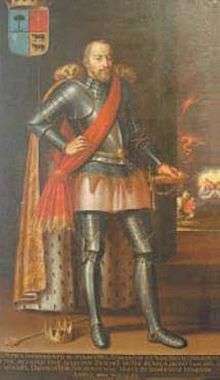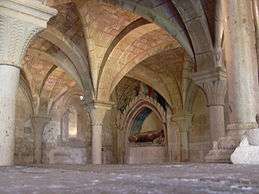Pedro de Atarés
| Pedro de Atarés | |
|---|---|
| Lord of Atarés, Aibar, Javierrelatre and Borja | |
 Portrait of Pedro de Atarés at the Zaragoza Museum | |
| Noble family | Jiménez dynasty |
| Father | García Sánchez |
| Mother | Teresa Cajal |
| Born | c. 1083 |
| Died |
21 February 1151 Borja |
| Buried | Veruela Abbey |
Pedro de Atarés (c. 1083, Borja – 21 February 1151[1]) was a Spanish noble and member of the House of Aragón. He founded the Veruela Abbey, the oldest Cistercian monastery in Aragon.
Biography
Family
Pedro de Atarés was the son of García Sánchez, Lord of Aibar, Atarés, and Javierrelatre, and grandson of Sancho Ramírez, Count of Ribagorza,[2][lower-alpha 1] an illegitimate child of King Ramiro I.[4][5] His mother was Teresa Cajal, a sister of Fortún Garcés Cajal, one of the most powerful magnates in the Kingdom of Aragón.[1]
Pretender to the throne
Lord of Atarés and Javierrelatre, which he inherited from his father, and of Borja, thanks to the donation by King Alfonso VII of Castile,[6] Pedro de Atarés was one of the claimants to the throne of Aragón after the death, without issue, of King Alfonso I the Battler.[6] According to the Crónica de San Juan de la Peña, written in the 14th century, his haughty behavior cost him the crown and the Aragonese barons in an assembly chose the deceased king's brother who reigned as Ramiro II.[7] [8]
Founder of Veruela Abbey

In 1146,[lower-alpha 2] Pedro de Atarés founded Veruela Abbey (Real Monasterio de Santa María de Veruela),[2] the most ancient Cistercian monastery in Aragon,[9][11][12] with a donation, also confirmed by his mother, to the abbot of the Escaladieu Abbey in France.[lower-alpha 3] This donation was later confirmed in 1155 by Count Raymond Berenguer IV.[6][9]
Death without issue
Pedro de Atarés died on 21 February 1151 and was buried at the abbey which he had founded. Although he died without leaving any children,[2] members of the House of Borgia invented a genealogy tracing their origins back to this member of the royal house coinciding with the third wedding of Lucrezia Borgia to Alfonso I d'Este, Duke of Ferrara, which was arranged by her father Pope Alexander VI.[13] Nevertheless:
The legend spread by the family that the Borgia were descendants of this gentleman of royal blood, Don Pedro de Atarés (...), lord of Borja which entitled them to use the double crown of Aragón in their coat of arms, is false. The truth is quite different. Don Pedro de Atarés died in 1151 and there is no doubt that he left no descendants.[14]
Notes
- ↑ In a donation made by Garcia to Galindo Garcés de Artosella consisting of some houses in Huesca and other properties, he states at the beginning: Ego Garcia infans, filius Sancii Ranimiri comitis (I Garcia, infante, son of count Sancho Ramírez), and in the last part of the document, he confirms as, ego Garcia infans in Atares et in Exabierre.[3]
- ↑ Laurent Dailliez affirms that the date is incorrect and that the monastery was founded in 1145.[9][5][10]
- ↑ Ego Petrus Taresa cum matre mea facio hanc cartam donationis et confirmationis vobis, abbati Scalae Dei (I, Pedro Teresa with my mother make this donation and confirmation letter to you, abbot of Scala Dei). He appears with this name in other documents.[6]
References
- 1 2 Cabanes Pecourt 1995, p. 17.
- 1 2 3 Mathew 1912, p. 22.
- ↑ Lacarra 1982, p. 58, doc. 44.
- ↑ Lapeña Paul 2004, pp. 46, 48.
- 1 2 Alonso Álvarez 2007, p. 662.
- 1 2 3 4 Alonso Álvarez 2007, p. 691.
- ↑ Orcástegui Gros 1985, pp. 465–466.
- ↑ Nelson 1991, p. 31.
- 1 2 3 Díaz Barón 1992, p. 168.
- ↑ Melero Moneo 2004, p. 10, n. 10.
- ↑ Cabanes Pecourt 1995, p. 22.
- ↑ Alonso Álvarez 2007, pp. 662, 691.
- ↑ Batllori 1999, p. 14.
- ↑ Nadal Cañellas 2006, p. 175.
Bibliography
- Alonso Álvarez, Raquel (2007). "Los promotores de la Orden del Císter en los Reinos de Castilla y León: Familias aristocráticas y damas nobles". Anuario de Estudios Medievales (in Spanish). Barcelona: Universidad de Barcelona. Instituto de Historia Medieval de España (37/2): 653–710. ISSN 0066-5061.
- Batllori, Miguel (1999). La familia de los Borja (in Spanish). Madrid: Real Academia de la Historia. ISBN 84-7820-823-2.
- Cabanes Pecourt, Mª de los Desamparados (1995). "Datas históricas de la documentación de Veruela del siglo XII" (PDF). Aragón en la Edad Media (in Spanish) (12): 13–28. ISSN 0213-2486.
- Díaz Barón, Mª Gloria (1992). "Las relaciones del Monasterio de Veruela y Bulbuente: el cumplimiento de la carta de población de Villamayor" (PDF). Turiaso (in Spanish). Zaragoza: Institución Fernando el Católico: Centro de Estudios Turiasonenses (10/1): 163–180. ISSN 0211-7207.
- Lacarra, José María (1982). Documentos para el estudio de la reconquista y repoblación del Valle del Ebro (in Spanish). I. Zaragoza: Anubar Ediciones. ISBN 84-7013-192-3.
- Lapeña Paul, Ana Isabel (2004). Sancho Ramírez, rey de Aragón (¿1064?-1094) y rey de Navarra (1076–1094) (in Spanish). Gijón: Ediciones Trea. ISBN 84-9704-123-2.
- Mathew, Arnold H. (1912). The Life and Times of Rodrigo Borgia, Pope Alexander VI. New York: Brentano's. ISBN 84-9704-123-2.
- Melero Moneo, Mª Luisa (2004). "Reflexiones sobre el monasterio cisterciense de Santa María de Fitero" (PDF). De arte: revista de historia del arte (in Spanish). León: Universidad (León) Facultad de Filosofía y Letras (3): 7–22. ISSN 1696-0319.
- Nadal Cañellas, Juan (2006). "La permanencia de Rodrigo de Borja (Alejandro VI) en el estudio de Bolonia, según documentos originales". Acta histórica et archaeologica mediaevalia (in Spanish). Barcelona: Universidad de Barcelona. Departamento de Historia Medieval (27–28): 173–205. ISSN 0212-2960.
- Nelson, Lynn H. (1991). The Chronicle of San Juan de la Peña. A Foureenth-Century Official History of the Crown of Aragon. Translated, with an Introduction and Notes by Lynn H. Nelson. Philadelphia: University of Pennsylvania Press. ISBN 0812213521.
- Orcástegui Gros, Carmen (1985). "Crónica de San Juan de la Peña (versión aragonesa): Edición crítica" (PDF). Cuadernos de historia Jerónimo Zurita (in Spanish). Zaragoza: Institución Fernando el Católico (51–52): 419–569. ISSN 0044-5517.